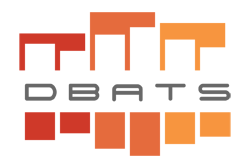DBATS - DataBase of Aggregated Time Series
 DBATS is a high performance time series database engine optimized for
inserting/updating values for many series simultaneously. DBATS can easily
sustain write speeds of more than 1.6 million values per second, and CAIDA has
used DBATS databases with more than 40 million distinct series.
DBATS is a high performance time series database engine optimized for
inserting/updating values for many series simultaneously. DBATS can easily
sustain write speeds of more than 1.6 million values per second, and CAIDA has
used DBATS databases with more than 40 million distinct series.
Since DBATS is a low-level time series database engine, it has limited tools for
inserting and querying data. As such, DBATS should be used in conjuction with
mod_dbats (included in this release) to provide a Graphite-compatible HTTP read
interface, and with libtimeseries
to provide a high(er)-level write API.
DBATS is based on TSDB, with differences indicated below.
Download
DBATS version 0.1 is available for download.
- Berkeley DB 5.x (preferably 5.3 or later)
Dependencies
The mod_dbats apache httpd module additionally requires:
- Apache httpd 2.2 or later
- apxs (should be included with Apache)
Introduction
A DBATS time series is a sequence of data entries measured at regular time intervals. A set of similar time series with the same period and entry size is a "bundle". Each time series in a bundle is identified by a user-defined string key and an automatically assigned integer key id. The primary bundle stores the original raw data. Additional "aggregate" bundles can be defined that merge sub-sequences of data points for a key in the primary bundle into single data points for the same key in the aggregate bundle.
Conceptually, DBATS stores a bundle in a logical table where rows are time and columns are metric keys, and each cell entry contains an array of one or more 64-bit values. Each row of an aggregate bundle table corresponds to a set of rows in the primary data bundle table.
Internally, DBATS uses a number of BDB databases (tables):
key_name -> key_idkey_id -> key_namebundle_id -> { agg_func, steps, period, time_range }{ bundle_id, time, frag_id } -> is_set_fragment{ bundle_id, time, frag_id } -> data_fragment
Each metric key is assigned an id when it is created. Keys can not be deleted
and key ids can never change. Data fragments are blocks of 10000 data entries,
covering sequential key_ids with the same time and bundle_id. Data fragments are
stored compressed in BDB. Is_set_fragments are corresponding blocks of flags
indicating whether each entry is actually set. Aggregate values are calculated
immediately (in the same transaction) when primary values are set.
The design is optimized for inserting many values in the same timeslice before moving to another timeslice.
DBATS is based on TSDB, with the following key differences:
- aggregation series (calculated at insert time)
- option to truncate old series values
- functions to iterate over list of keys
- faster reading with key id
- ACID transactions
- 64 bit values
Building
To build and install dbats:
./configure [options]
make
make check ;#(optional)
make install
To install the optional mod_dbats apache module:
As root (or other user with permission to restart apache), run
"make install-apache" in the dbats build tree. This will do the
following:
- if an old dbats module is already loaded, disable it and restart server
- install and enable the new dbats module
- restart apache server
Most of the GNU standard configure options and make targets are also available.
If your libdb is installed in a nonstandard location $dir/lib and
the corresponding db.h header is in $dir/include, you should use the
./configure option "--with-libdb-prefix=$dir". This should work whether
libdb is static or shared.

